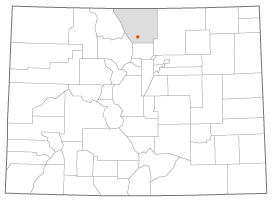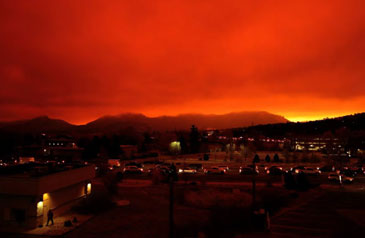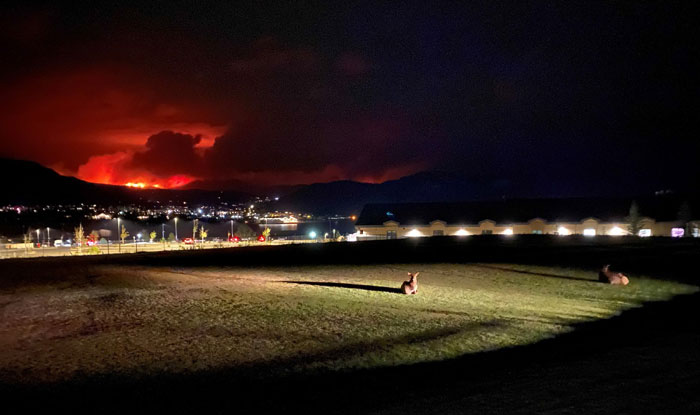Wildfire Forces Evacuation of Critical Access Hospital in Estes Park, Colorado
What Happened

Multiple devastating wildfires burned across Colorado, California, and the western United States throughout 2020. This included the top 2 largest fires in Colorado's history based on acreage burned: the Cameron Peak and the East Troublesome Fires. The Cameron Peak Fire began in early August 2020 and threatened Estes Park Health (EPH), a Critical Access Hospital (CAH) in Estes Park, Colorado, for several months. EPH serves the town of Estes Park and several small communities in Larimer County, Colorado, and is licensed for 23 beds, plus 2 birthing center rooms. EPH also has a Level IV trauma center and a highly equipped, 24-hour emergency department that can handle an influx of tourists. Additionally, EPH has an ambulatory clinic with healthcare providers offering services such as internal medicine, orthopedics, pediatrics, obstetrics, gynecology, and family practice.
Hospital staff worried that the winds might push the wildfire, which was burning a couple valleys over, closer to Estes Park. The CAH is situated to the east of Rocky Mountain National Park, near the park's main entrance. Though the small town has a population of around 6,500 permanent residents, it receives over 4 million national park visitors a year, with a significant tourist surge in the summertime. There was concern that the fire could move in the direction of the town with great speed, due to the enormous number of dead trees from a Mountain Pine Beetle infestation a decade prior. However, the fire avoided EPH, crossing about 4 to 5 miles north of the town of Estes Park and eventually moving down Poudre Canyon toward Fort Collins and other cities on the Front Range of the Rocky Mountains in Larimer County.
As the seasons turned to fall, anxiety about the Cameron Peak Fire subsided in Estes Park. However, on October 14, 2020, the East Troublesome Fire started over the Continental Divide on the other side of the Rocky Mountains, east of Troublesome Creek in Grand County. This wildfire took off at an accelerated rate and, in just a few days, grew to over 100,000 acres near the Grand Lake area. It became the second largest wildfire in Colorado, only behind the Cameron Peak Fire earlier that year, in terms of acreage destroyed.

In the early morning on October 22, 2020, some ash or cinder made its way over the mountain divide and landed in Spruce Canyon, located a few miles west of Estes Park. The trees, killed by beetles and more susceptible to fire, caught flame, and by noon that same day, Larimer County issued an emergency evacuation for the entire town of Estes Park. The speed at which EPH had to evacuate was a surprise to hospital staff and presented logistical challenges, despite prior planning.
The East Troublesome Fire was racing toward the town, said Gary Hall, Chief Operating Officer (COO) for EPH. He remembered the sky at 2:00 p.m. was “as dark as night” from the smoke of the approaching flames. Huge lines of traffic backed up as the town evacuated throughout the afternoon.

Hall has worked at EPH since 2005. He has remained through multiple administrations and staffing changes, inheriting many other roles and responsibilities over the years. In addition to his position as COO, he is the Chief Information Officer (CIO) and manages facilities, housekeeping, dietary, marketing, and ancillary clinical departments such as laboratories, radiology, pharmacy, and rehabilitative services at EPH.
EPH had only 3 inpatients and around 17 long-term care (LTC) residents when the evacuation began. Two of the 3 inpatients were discharged and sent home to evacuate with their families, while the remaining patient was placed at a partner healthcare facility further out on the Colorado plains.
Planning Success
Early in the course of the Cameron Peak Fire in 2020, EPH set up an Incident Command under Incident Command System (ICS) protocols to manage fire preparations, and each department director at the CAH developed or updated their evacuation plans to prepare for the possibility of the fire approaching the hospital. Ultimately, EPH never had to enact these plans during the Cameron Peak Fire. However, having these plans in place immensely helped EPH when it had to evacuate for the East Troublesome Fire. EPH had reviewed each department's shutdown procedure, so most of the departments followed the existing plans and executed their evacuations as expected in October 2020.

The biggest surprise was the speed with which the hospital was required to evacuate. EPH only had an hour to get their inpatients and residents transferred to transportation. Modifications to the existing plans were made following the event. The planning process now identifies 2 scenarios: the first outlines everything that needs to happen if EPH has reasonable time to evacuate, and the second outlines the absolute minimum requirements for a safe evacuation procedure when circumstances require immediate action. Despite these changes, the exercise of refreshing the departmental evacuation protocols in the summer of 2020 was very valuable for EPH during the East Troublesome Fire response.
Evacuation Response
The EPH emergency department closed with the rest of the hospital. However, EPH emergency medical services (EMS) stayed in Estes Park to assist the firefighters, since they were trained in ICS for emergency management. During this time, they set up a mobile emergency department with ambulance crews and equipment close to the fire lines.
EPH administrators decided to let the major equipment in the CAH, such as lab analyzers and magnetic resonance imaging (MRI) and computed tomography (CT) machines, continue to run, in order to avoid a complete shutdown. Key focus areas during the response were patients and LTC residents as well as the emergency department and the clinical equipment — getting people out of harm's way and ensuring that vital machinery stayed running through the event took priority. As firefighters poured into the town, EPH staff gave the responders a quick tour of the hospital facilities in case they needed to close things down. The entire town began leaving at noon, and by 4:00 p.m., the CAH had been completely evacuated. Once the last administrators left, the hospital facilities were released to the Denver Fire Department.
Denver Fire responded to the East Troublesome Fire as soon as it sparked in Spruce Canyon near Estes Park. They responded with tanker trucks and began by spraying the trees, hospital, and surrounding buildings with water to deter the fire from destroying the hospital buildings and infrastructure if it encroached further on the town. The responders also knocked down multiple trees and dug out huge trenches to slow the wildfire's spread. The firefighters kept the flames away from the hospital for 3 to 4 days — the closest the fire ever got was about 2 miles from the CAH. Denver Fire's firefighting tactics kept the blaze away from the town until October 26, 2020, when the winds changed, and the first major snowstorm of the season hit the town.
Return and Recovery
The firefighting tactics, combined with the cooler temperatures and favorable winds, allowed the residents of Estes Park to return to the town on October 27, 2020. The state hospital inspectors had to approve the premises before EPH could be reopened. Though the hospital did not burn, cinder and ash littered the hallways. Hospital staff had to clean out all the debris and replace every filter in the hospital air conditioning and filtration units before opening again. Hall was surprised that EPH staff were able to walk back into the CAH and start using it without any major repairs. He was concerned that he would have to rebuild his server room, but it was untouched by the flames. EPH began opening services to the public again on October 30, 2020.
Other issues in the town included the logistical challenges associated with where residents could pick up their mail that had come during the evacuation and where town services would be provided until permanent services were restored. It took weeks for the rural town of Estes Park to get caught up with these services following the evacuation disruption. Fortunately, the fire was diverted about 2 miles to the west edge of the town, so utilities stayed intact, including power, water, and sewer access.
Success Factors
Communication
During 2020, in the months prior to the wildfires, EPH staff became very familiar with remote communication platforms due to work-from-home initiatives during the COVID-19 pandemic. Telecommuting, teleconferencing, and telehealth options were key to maintaining communication during the wildfire evacuation and aftermath. The leadership team as well as the physician team remained accessible through use of their personal smart phones and email, even though individuals evacuated to various locations in and out of the state of Colorado. The main concerns, according to Hall, were whether the hospital building was going to stay intact, whether utilities were going to continue, and whether EPH's information technology (IT) networks and services would continue running. If hospital IT services remained intact, said Hall, then hospital communications could continue remotely, which is why he had decided to leave all equipment running at the hospital before evacuating.
Once situated, Hall set up a remote workspace in Loveland, about an hour east of Estes Park, that became the central hub of communications for the following days. Hall also instituted measures to communicate with the residents of Estes Park in their various evacuation destinations. Using social media sites and email, he was able to communicate the status of the hospital as well as instructions on how to speak with a physician or primary care provider to receive care remotely. Changes were made to the EPH website to make it accessible and informative for evacuees during the incident.
Cloud Storage
Over the past dozen years, Hall had focused on transitioning the hospital's IT applications and databases to the cloud or external hosting as much as possible. This would help mitigate a loss of information, should EPH's physical premises become compromised. During 2020, the vast majority of patient information was housed in a larger hospital system on the Front Range of Colorado, away from the 2 large fires. Thus, most of the important information Hall manages as CIO is housed externally, which contributed to EPH's relatively painless IT recovery after the evacuation.
Mountain Strong
EPH has faced many other disasters in the years prior to the East Troublesome Fire that helped develop its emergency response capacity. In September 2013, a large weather system caused catastrophic flooding on the Front Range in parts of northern Colorado and, according to a U.S. Forest Service article, Our Relationship with a Dynamic Landscape: Understanding the 2013 Northern Colorado Flood, killed 10 people across multiple counties. After the flood, a third of the town's sewer system was knocked out for several months. Estes Park has also faced town-wide communication outages, a cyberattack on the CAH, crippling winter storms, and the COVID-19 pandemic.
Leadership
EPH has not had much administrative turnover since experiencing the wildfires in 2020. Since the CAH's leadership has largely stayed the same, the events of the East Troublesome Fire evacuation are “embedded in the minds and souls and the DNA” of those who experienced the incident. This positions EPH in a good place for emergency preparedness, especially coming off the COVID-19 pandemic. Monthly emergency planning and preparedness meetings are focused on updating processes for future emergencies but, “from an institutional knowledge and readiness” standpoint, Hall is confident in the CAH's ability to respond to real events.
Partnerships
EPH has a great relationship with the town of Estes Park, as well as with Larimer County officials, that allowed them to maintain emergency management information sharing. During the East Troublesome Fire response, the CAH had an emergency liaison for the town and county — a role which Hall and the director of EPH EMS have since come to share as of 2022. As important were the relationships and liaisons with other hospitals and healthcare facilities located further along the Front Range. These partnerships allowed the CAH to safely relocate their patients and LTC residents during the evacuation. EPH also had an established memorandum of understanding with Estes Park School District R-3, the local school district, to provide additional transportation for their charges. This measure was doubly important for maintaining social distancing to prevent COVID-19 while evacuating. Emergency preparedness contractors held memoranda of understanding (MOU) with the CAH as well. For example, a fuel provider worked with Hall to arrange for the provision of emergency power, should the hospital lose access to utilities and need to run emergency electrical generators. Multiple partnerships with private and public sector contractors, as well as government agencies such as the school district, contributed to the success of the CAH's emergency evacuation and response.
Resilience
As a Level IV trauma center hospital, EPH staff were used to dealing with emergencies and critical situations when the evacuation need arose. Even those with non-patient-facing roles experience a high-stress environment on a daily basis. According to Hall, the hospital employees' “strength and resilience and ability to think logically through the crisis” gave the CAH an advantage during emergency response.
Barriers
Long-Term Care
In 2020, EPH had a small LTC facility housed with the hospital. This presented significant challenges, as the CAH had to designate special focus to evacuating the non-mobile residents. There were multiple elderly individuals who could not evacuate themselves, so a “human chain” of healthcare workers was formed to help transfer the residents in their wheelchairs to ambulances and evacuation buses.
A few days before the evacuation order, the LTC unit documented its first cases of COVID-19 among residents, 7 months into the pandemic. COVID-19 presented its own issues, and COVID-positive residents had to be transferred separately from the other residents. Masks during the evacuation served the dual purpose of preventing the spread of COVID-19 and the inhalation of smoke from the air.
EPH leveraged their existing MOU with Estes Park School District R-3 to use school buses in the event of an evacuation. The main challenge was assembling the staff needed to complete the evacuation — many leaders and employees, including the Chief Executive Officer (CEO) of EPH, assisted in evacuating the nursing home. During preparation for the Cameron Peak Fire, the CAH established an agreement to place their residents at a nursing home in Greeley, a town about an hour and a half east of Estes Park, further out on the plains of Colorado.
Age
In addition to complications with evacuating the nursing home, EPH faced challenges based on the demographic makeup of the town itself. Just over 40% of the population of Estes Park is age 65 or older, according to the 2020 U.S. Census. While an aging population in and of itself is not a problem, demographics must be considered by planners and responders in an emergency situation. One such factor is that of communication — Hall used social media and email to keep Estes Park residents updated on hospital operations and healthcare opportunities during the time when the town was evacuated. Many older adults, however, were not comfortable using electronic and internet-based communications. Therefore, EPH also supplemented digital communication with traditional outreach methods, such as phone calls.
Human Factors
During the evacuation, EPH had difficulties balancing the needs of their patients with the needs of their staff. With very little notice that the town would need to be evacuated, hospital staff wanted to go home and pack up their houses and families for their own evacuations. Staff, said Hall, remained calm and logical due to their previous experience working with critically ill or trauma patients in high-stress situations, which led to good personal and organizational readiness during the event. A significant challenge was determining when staff should leave the hospital to evacuate their families and homes. Especially for those who lived alone or had a spouse who was also working, being able to go home, collect their belongings, and pack their children and pets into their vehicles became a high-priority concern. As the afternoon progressed, there were fewer and fewer hospital staff to assist in preparing the facilities and patients. “When to leave” was left up to the individual, as Hall expressed that EPH could not expect staff to stay at the expense of their families, pets, or homes. He remembered being one of the last to leave the hospital that day.
Human beings have limits, said Hall. The “existential weariness” of the nursing profession by late 2020 was severe, due to fatigue, grief, and burnout related to the COVID-19 pandemic. This weariness is not just limited to nursing staff but also to laboratory technicians, radiology technicians, and other support staff in the healthcare setting. Hall, in his facilities manager role, has had difficulties maintaining environmental and housekeeping services staff throughout the pandemic. By the time of the East Troublesome Fire in 2020, Hall said that the healthcare organization was weary. This continued through 2021 and beyond. He noted that 2021 was supposed to be a year of recovery, yet EPH was still dealing with COVID-19 surges and worries about fires. This anxiety carried over into 2022, especially in the drier months, as spot fires cropped up in the middle of winter and the town's post-traumatic stress disorder (PTSD) flared.
Seasonality
Since Estes Park experiences a large influx of tourists visiting the Rocky Mountain National Park each year, the CAH faces different challenges in the summer compared to the winter. Estes Park is not a ski town, so they are never as busy in the wintertime as they are in the warmer months. This causes staffing challenges at EPH. EPH must keep a sufficient number of trained, experienced staff year-round. While this is not a factor that affects the hospital's emergency preparedness, said Hall, it certainly affects its clinical readiness and emergency response capacity. In order to handle the summer swing, hospital administrators must ramp up but also be able to retain staffing throughout the year. This can sometimes lead to spending deficits for the CAH.
Mother Nature
One of the constant challenges for the residents of Estes Park is not knowing what nature will do. There is a huge amount of dead timber in Colorado called beetle-kill wood, as a result of the Mountain Pine Beetle that destroyed large parts of the forests. Hall expressed worry that the area is going to catch fire and spread rapidly someday, just as Grand Lake did during the East Troublesome Fire. One spark is all it takes to lead to these types of disasters, whether from lightning, careless campers, or other causes. Dry seasons without adequate rainfall are particularly dangerous. EPH is a CAH — the nearest hospital is a 45-minute drive away. With the threat of more wildfires, the surrounding community is in jeopardy in regard to emergency healthcare. Additionally, EPH is at risk during winter storms, which may cause freezing, blizzards, high winds, flooding, lightning, hail, and more. Emergency planners cannot predict nor control nature; however, they must do their best to prepare for potential hazards and prevent the loss of essential services.
Lessons Learned
Time Compression
The challenges associated with an immediate evacuation were not thoroughly explored during the initial evacuation planning process for the Cameron Peak Fire. The East Troublesome Fire, however, was fanned by unfavorable winds and spread over 100,000 acres in just a few days. Once the fire jumped over the mountain divide into Spruce Canyon, it was only a few miles from Estes Park. The town was ordered to evacuate at noon that same day, leaving no time to plan. Ultimately, the evacuation worked well, but it was challenging due to the pace of the evacuation and congestion of the roads out of town. EPH learned to consider the highly improbable during emergency planning, because it is possible, and it is better to overprepare than be caught by surprise.
Remote Staffing
The challenge of remote work for hospital positions has been a concern for EPH since the beginning of the COVID-19 pandemic in early 2020. The fire exacerbated these concerns as hospital essential functions had to continue during the evacuation. The CAH conducted an analysis to determine who in the organization could perform remote work, including billing, human resources, finance, and even doctors in certain documentation capacities. The hospital also launched a telehealth program in 2020 that allowed primary care providers and physicians to evaluate patients for certain ailments that do not require an in-person assessment. Between the COVID-19 pandemic, the wildfire, and “the evolution of the world,” EPH has learned important lessons in how to properly set up safe and secure remote access environments to provide patient care.
Emergency Compensation
One challenge for the EPH administration in the aftermath of the emergency evacuation was deciding what to pay their employees. Staff were not working while they were evacuated, and the hospital was considering whether they would need to use paid time off (PTO) or vacation time. Ultimately, the CAH decided to pay their staff for the evacuation time and were able to get insurance reimbursement eventually as well.
Advice
For rural communities and CAHs responding to similar emergencies, Hall provided the following advice:
Emergency Preparedness
Evacuation is only one aspect of an emergency response. The majority of events EPH has experienced, said Hall, have required shelter-in-place but not evacuation. Planners must make sure that the emergency generators are tested regularly and can handle the full load they are required to hold; ensure that potable water is available, stored in a place where it will remain fresh, and in sufficient quantities to give to patients for drinking and bathing; and have a backup plan in the event that the building loses air conditioning in the summer or heating in the winter. These and other concerns are important because most crises result in maintaining operation in place.
Continuous Planning
Planning for emergency response should be a regular, ongoing event that involves a committee made up of the appropriate people within the healthcare organization. Emergency response planning is required of the CAH by Medicare, said Hall — however, the regularity of planning is what keeps people and organizations as safe as possible. Partnerships should be established in advance with suppliers and government agencies; it is important to have these relationships in place before an emergency event. Regular planning and drills may reveal discrepancies, noted Hall, such as the need to update evacuation plans, train staff members in the ICS processes, or set up a room to become an emergency command center. If the planning committee meets regularly, then they have a higher chance of understanding and addressing what needs to be done to prepare.
Hall emphasized to keep emergency planning “percolating all the time.” Organizations should complete drills once or twice a year. If there is not a real crisis happening, tabletop exercises give responders the opportunity to talk through a situation and exercise emergency response logic in a non-threatening scenario. Hall likened preparedness to an actor onstage, saying, “You can rehearse those lines and know them well, but when you step on a stage in front of a live audience, that's when you find out how well you really know your lines.” Events may occur where you do not know what to do next. The reality of an emergency event, he said, will always add new stress and surprising variables on top of the situation. That is why continuous planning and emergency preparedness exercises are vital and why individuals and organizations must strive to learn how to remain rational and logical, no matter what circumstance may arise.
Person(s) Interviewed
Gary Hall, Chief Operating Officer (COO), Chief Information Officer (CIO)
Estes Park Health, Park Hospital District
Opinions expressed are those of the interviewee(s) and do not necessarily reflect the views of the Rural Health Information Hub.
